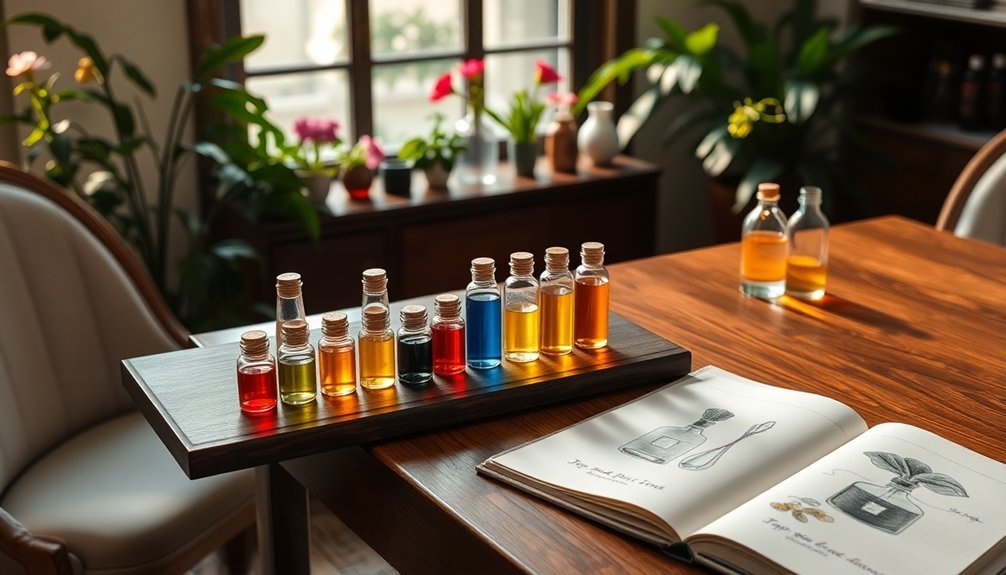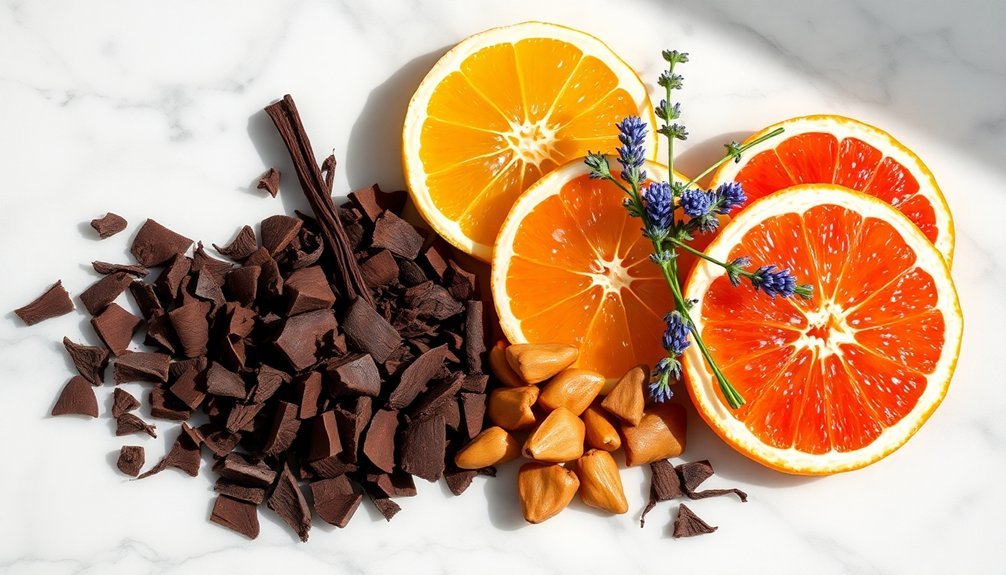To pair fragrance notes like a pro, start with a strong base note like vanilla or sandalwood as your foundation. Layer lighter top notes over this base, using 1-2 spritzes of each. Let the combination develop for 30 minutes to assess how the scents interact on your skin. Test new pairings on paper strips first, and keep floral top notes with warm bases for natural harmony. Master these basics, and a world of sophisticated scent combinations awaits.
Understanding The Language of Scent Notes

When diving into the world of fragrances, you'll quickly discover that scents speak their own unique language through notes.
Think of these notes as a musical composition, where each layer plays a vital role in creating the perfect harmony. Top notes greet you first with their fresh, citrusy bursts, lasting just 15-30 minutes before fading.
The middle note then takes center stage, offering floral or spicy elements that can persist for hours. Finally, the base notes anchor your fragrance with rich, deep scents like vanilla or musk that linger for days.
Understanding this structure is essential for successful fragrance layering.
When you're creating scent combinations, you'll want to start with stronger base notes and build up to lighter top notes, ensuring each layer complements the others perfectly.
Essential Tools for Note Pairing Success
You'll need test strips and cards to sample different scent combinations without overwhelming your nose or skin during the pairing process.
A proper storage solution with temperature control helps maintain the integrity of your fragrances, ensuring consistent results when you're experimenting with various note combinations.
To understand how scents interact with your unique body chemistry, invest in a skin chemistry testing kit that lets you analyze how different fragrance molecules react on your skin over time.
Test Strips and Cards
Test strips and cards serve as indispensable tools in the art of fragrance layering, enabling you to discover perfect note combinations without the variables of skin chemistry.
When you're exploring scent combinations, let each fragrance settle on the strips for at least 30 minutes to understand how the top notes shift into base notes over time.
To maximize your testing experience, use unscented strips to prevent cross-contamination between different fragrances.
Don't forget to label each strip with the fragrance name – you'll want to remember your successful pairings for future reference.
Working with multiple strips simultaneously allows you to compare various combinations side by side, making it easier to identify which top and base notes create the most harmonious blend.
Quality Scent Storage Solutions
Proper storage of your fragrances plays an essential role in maintaining their intended note profiles for successful layering experiments. To protect your scent storage investment, keep your bottles in a cool, dark environment where volatile compounds won't break down from heat or UV exposure.
You'll want to invest in a quality scent organizer that allows you to store bottles upright and categorize them by their note families. When layering perfumes, this organization system helps you quickly locate complementary scents.
Use opaque or tinted containers to shield your fragrances from harmful light, and consider keeping sample vials handy for experimenting with different combinations. This approach preserves your main bottles while giving you the freedom to discover exciting new scent pairings without compromising your collection's integrity.
Skin Chemistry Testing Kit
A well-equipped skin chemistry testing kit serves as your foundation for successful scent layering. With fragrance strips, you'll be able to evaluate top note and base note combinations objectively before they interact with your skin chemistry.
Using the included pipettes, you can create precise measurements when mixing different scent combinations, ensuring consistent results every time you blend.
Store your successful blends in the kit's sample vials to recreate your favorite combinations later. Since your skin chemistry plays an essential role in how fragrances develop, you'll want to test promising combinations on your skin after initial strip testing.
This methodical approach helps you understand how different notes interact with your unique chemistry, leading to more sophisticated and personalized layered fragrances that truly complement your natural scent profile.
The Science Behind Top and Base Compatibility
Understanding the science behind fragrance compatibility reveals fascinating chemical interactions between top and base notes. When you're creating a fragrance blend, you'll notice that top notes evaporate quickly while base notes provide lasting depth.
The key lies in matching scents within complementary fragrance families. You'll achieve the best results by layering lighter, volatile top notes with rich base notes that share harmonious characteristics.
For instance, floral top notes naturally complement warm vanilla or sandalwood base notes, creating a balanced scent profile. The secret is maintaining proper proportions – your top notes shouldn't overpower the base, but rather enhance it.
As you experiment with different combinations, you'll discover how skin chemistry affects the way these notes interact, transforming your unique fragrance journey.
Mastering the Art of Note Balance

You'll achieve the most harmonious fragrance combinations by following the "light over heavy" principle, always layering your lighter top notes after applying heavier base notes.
Before committing to a full application, test your chosen combination on a small patch of skin and give it time to develop, allowing you to observe how the scents interact.
Match the intensity levels of your chosen notes carefully, ensuring neither the base nor top notes dominate the blend too strongly.
Layer Light Over Heavy
Creating a balanced fragrance composition requires mastering the art of layering, with heavier base notes serving as the foundation.
You'll want to start by applying one to two spritzes of your chosen base notes, such as vanilla or sandalwood, letting them settle into your skin before proceeding.
Once your base notes are in place, you can layer your lighter top notes over them.
These fresher scents, like citrus or florals, shouldn't overpower the deeper foundation you've established. Instead, they should complement and enhance the overall fragrance profile.
Give your layered scents about 30 minutes to develop and mature on your skin.
During this time, you'll notice how the different notes interact and blend together, creating a harmonious and sophisticated scent combination that's uniquely yours.
Test Before Full Application
Before committing to a full application of layered fragrances, smart perfume enthusiasts take time to test their combinations. By sampling fragrance notes on paper, you'll get a clear picture of how scents interact without the influence of your body chemistry.
Start with the stronger base note, then layer your chosen top note over it. Allow your test combination to develop for about 30 minutes – this reveals how the scents evolve together.
Keep your initial experiments simple by working with just two or three scents at a time. This approach helps you maintain control and prevents overwhelming results.
For the most accurate test results, make certain you're starting with a neutral base by using unscented products beforehand. This method helps you perfect your scent combinations before applying them to your skin.
Match Intensity Levels
The delicate art of fragrance layering hinges on achieving the right balance between intensity levels. When you're combining scents, start with a strong base like vanilla or sandalwood, then carefully layer your top notes to create harmony in your fragrance blend.
You'll want to keep your combinations simple by pairing one dominant base with just one or two lighter top notes. This approach prevents any single element from overpowering the others.
Remember that top notes evaporate more quickly than base notes, so consider this when planning your blend's intensity. Start with one to two spritzes of your top note on pulse points to complement your base.
Before committing to a full application, test your combination on paper to ascertain the intensity levels work well together.
Popular Top and Base Note Combinations

While perfume creation is an art form, successful fragrances often rely on tried-and-true combinations of top and base notes that complement each other perfectly.
When combining two fragrance elements, you'll find that vanilla base notes pair wonderfully with citrus top notes, creating an inviting yet revitalizing blend.
For a floral scent that exudes sophistication, try matching jasmine or rose top notes with sandalwood or musk bases.
If you're seeking a natural essence, combine fresh notes like basil or mint with rich amber bases.
Want something more adventurous? Pair spicy top notes such as pink pepper with deep patchouli or cedarwood.
For a lighter approach, try fruity top notes like pear or apple with gentle white musk or cedar bases.
These combinations create well-balanced, appealing fragrances.
Creating Seasonal Scent Harmonies
Creating enticing seasonal fragrances requires understanding how top and base notes can mirror nature's changing moods throughout the year.
You'll discover that each season calls for unique scent harmonies that capture its distinct character.
In spring, pair delicate peony top notes with warm musk base notes to create a fresh, awakening fragrance.
Summer calls for bright citrus top notes combined with coconut or amber bases, perfect for that tropical vibe.
When autumn arrives, mix spicy cinnamon or clove top notes with deep patchouli or cedarwood base notes for a cozy seasonal scent.
Winter's crisp atmosphere comes alive when you blend pine or mint top notes with rich oud or frankincense bases.
These thoughtful combinations guarantee your fragrances perfectly complement each season's unique atmosphere.
Next-Level Techniques for Advanced Blending

Moving beyond seasonal scent combinations, mastering advanced blending techniques opens up endless possibilities for creating sophisticated fragrances.
Start by applying a fragrance primer to create an ideal foundation for your custom blend. Then, select a strong base note like vanilla or sandalwood, which will anchor your composition and guarantee lasting power.
Next, introduce your chosen top note with precision, whether it's a bright citrus or delicate floral. You'll want to experiment with different proportions until you find your perfect balance.
For the best results, apply one to two spritzes of each note, and give your layered scent at least 30 minutes to develop. This waiting period is essential as it allows you to assess how the fragrances interact and mature on your skin.
Frequently Asked Questions
What Perfume Notes Go Well Together?
You'll find floral notes like rose pair beautifully with vanilla, while citrus works great with musk. Try combining fruity scents with amber, spicy notes with tonka bean, or fresh greens with coconut.
How to Blend Top, Middle, and Base Notes?
Start with the base note like vanilla, add middle notes such as jasmine, and finish with top notes like citrus. You'll want to test on paper first to verify they're blending harmoniously.
What Two Scents Smell Good Together?
You'll love pairing vanilla with citrus for an uplifting blend, or try sandalwood with rose for elegant depth. Musk and bergamot create warmth with freshness, while patchouli and pear offer an intriguing contrast.
What Fragrances Layer Well Together?
You'll create stunning combinations by layering fresh citrus with warm vanilla, rose with amber, wild strawberry with oud, or citrus-rose with sandalwood. White lavender and orange blossom also pair beautifully with rose fragrances.
In Summary
You're now equipped to create stunning fragrance combinations that tell your unique scent story. Take what you've learned about pairing top and base notes, trust your instincts, and don't be afraid to experiment. Remember that the best blends often come from understanding the rules, then tastefully breaking them. Start with proven combinations, then branch out to develop your signature scent style.





Leave a Reply